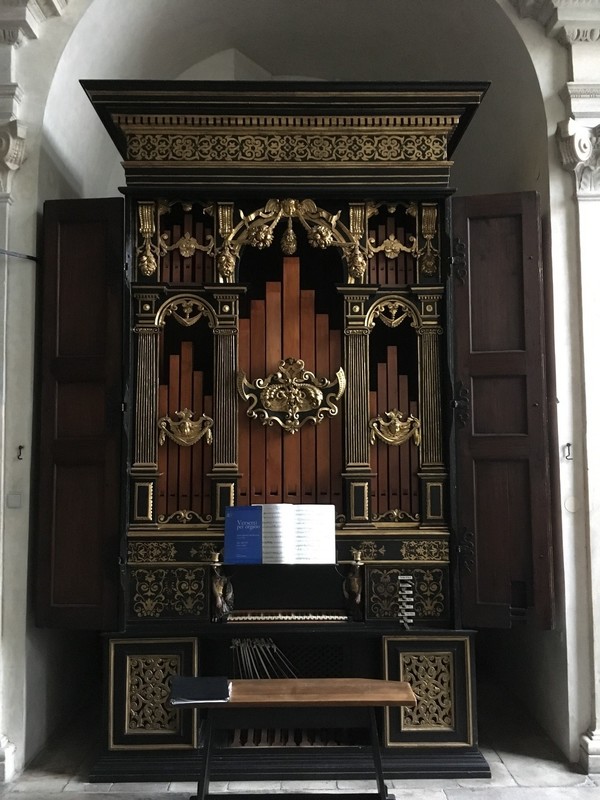A Wooden Organ in a Silver Chapel
One of the very few surviving organi di legno is an anonymous instrument in the Silberne Kapelle of the Hofkirche in Innsbruck. Of Italian origin, it was built around 1580 and later transported through the mountains to Innsbruck, likely for Anna Caterina Gonzaga of Mantua, who married the Archduke Ferdinand II in 1582. As a rare exemplar of the once popular organo di legno, the Innsbruck organ is a sort of historical bottleneck, singularly representing what was once a widespread and multi-functional instrument. It has served as a principal model for reconstructions of organi di legno in the twentieth and twenty-first centuries.[2]
However, the Innsbruck organ is by no means a typical example of the organo di legno. It is a large instrument, fixed in place, with seven ranks of pipes – so, considerably bigger than the moveable organs described by Nicola Vicentino or intended by the anonymous author of Il Corago. And while the organ was most surely used to accompany voices, its location within a chapel of a large church makes it a little unnatural to conceive of it as an instrument for theatrical music.
Like most organs of its age, this organo di legno has undergone considerable alterations during its long life, including major changes in the twentieth century. Having been disassembled towards the end of the Second World War, the organ was restored in 1950-52. In the process, pipes of different ranks were mixed together, radically changing the timbres and voicing of the individual ranks. The restorer also decimated one rank, the undulating Fiffera (tuned slightly sharp to create a beating, vibrato-like effect), using its pipes to fill in for missing pipes in the Principale, Ottava, and Decimaquinta ranks. Shortly after this problematic restoration, the Austrian musicologist Josef Mertin studied the Innsbruck organ in order to build a new organo di legno (discussed here).
The Innsbruck organo di legno subsequently underwent additional restorations in the 1990s that undid some of the work done in the 1950s. While the organ, in its current state, can give us an approximation of what this organo di legno may have sounded like in early modern times, it is just that, and it is difficult to assess the extent to which what we hear today differs from the sound of the organ in earlier centuries. And even if we could hear the original sound, it still would represent the sound of just one, rather unusual organo di legno. The Innsbruck organ serves as a vital yet complicated piece of evidence.
[2] For more on the Innsbruck organo di legno see Gerardus de Swerts, Pier Paolo Donati, and Reinhard Böllmann, “Die italienische Orgel der Silbernen Kapelle – Beschreibung, Restaurierung, Spurensicherung,” and id., “Organo di legno – Überlegungen zu Typus und Provenienz des Innsbrucker Instruments,” in: Die Orgeln der Hofkirche in Innsbruck, ed. Kurt Estermann, vol. 2, Tiroler Orgelschatz 5 (Innsbruck; Esslingen; Bern-Belp: Helbling, 2019), 64–159 and 160–169.
Citation: Leon Chisholm, ‘The organo di legno’s timbral timber’, in: Materiality of Musical Instruments. A Virtual Exhibition.

